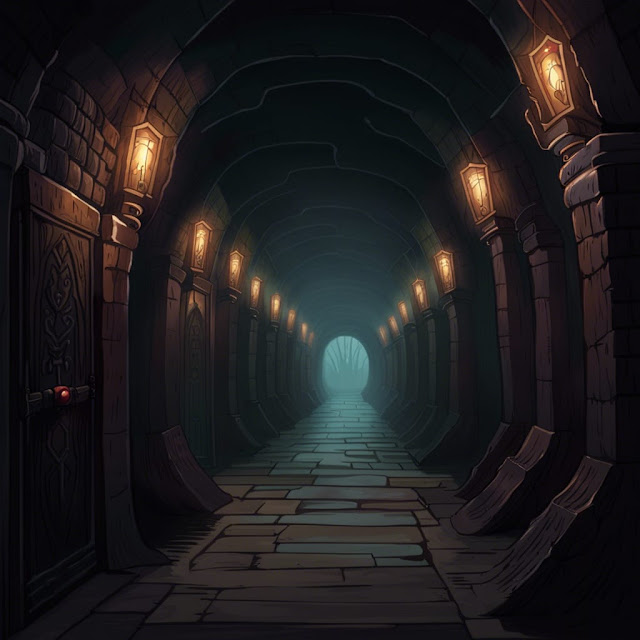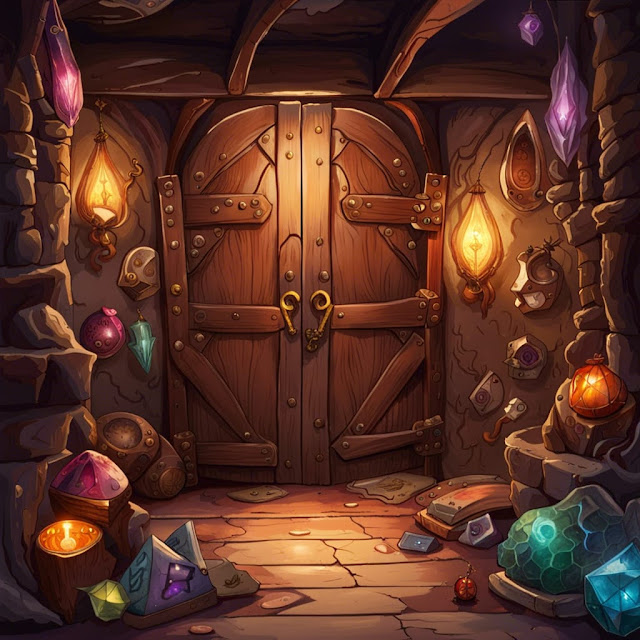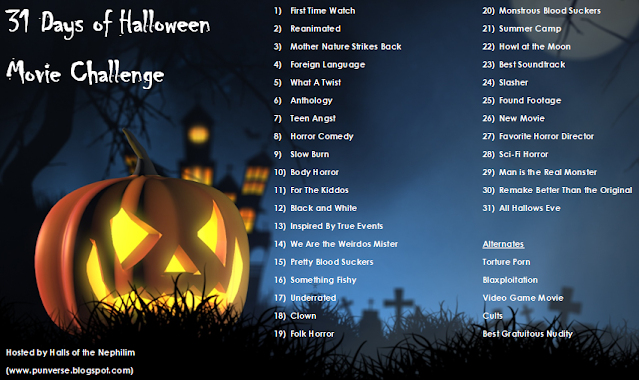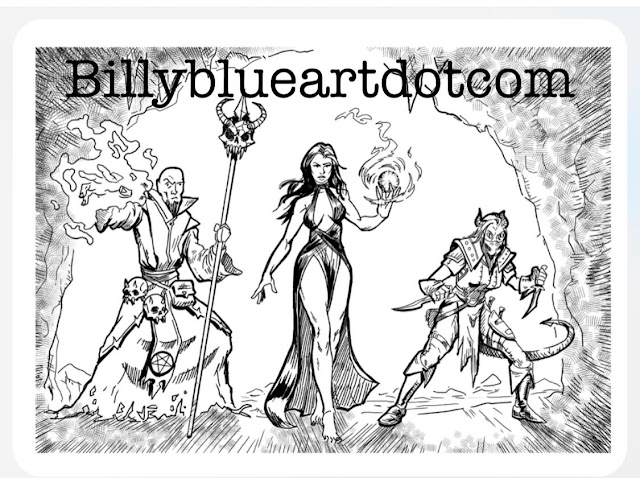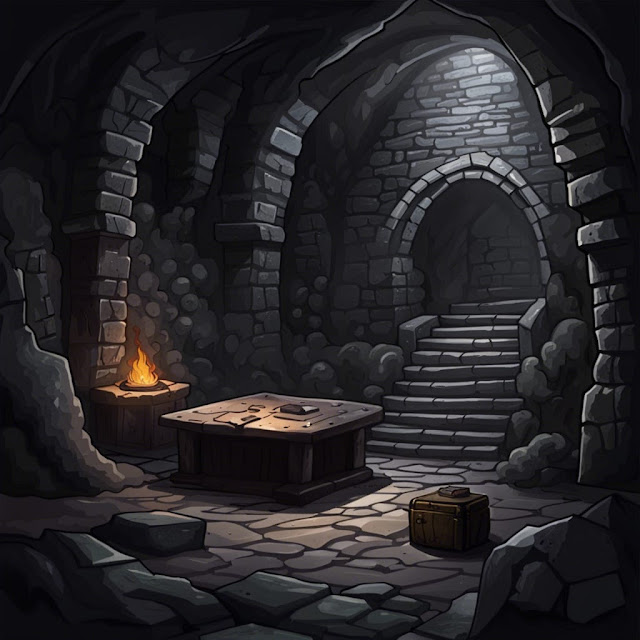1974 is an important year for the gaming hobby. It is the year that Dungeons & Dragons was introduced, the original RPG from which all other RPGs would ultimately be derived and the original RPG from which so many computer games would draw for their inspiration. It is fitting that the current owner of the game, Wizards of the Coast, released the new version, Dungeons & Dragons, Fifth Edition, in the year of the game’s fortieth anniversary. To celebrate this, Reviews from R’lyeh will be running a series of reviews from the hobby’s anniversary years, thus there will be reviews from 1974, from 1984, from 1994, and from 2004—the thirtieth, twentieth, and tenth anniversaries of the titles. These will be retrospectives, in each case an opportunity to re-appraise interesting titles and true classics decades on from the year of their original release.
—oOo—

Twenty years ago, the roleplaying game hobby was very different. There was one dominant roleplaying game—
Dungeons & Dragons—and its Open Game Licence enabled its underpinnings to snake out and transform almost every other roleplaying into a reflection of
Dungeons & Dragons as publishers harnessed its familiarity and ubiquity. There was also a small, but vocal drive urging the hobby to pull away from this landscape, to set out for pastures new as publisher-creators harnessing the democratisation of design and ready access to self-publishing. How times have changed in 2023. There is one dominant roleplaying game—
Dungeons & Dragons—and its Open Game Licence enables creators and publishers alike to harness its familiarity and ubiquity. There was also a small, but vocal drive urging the hobby to pull away from this landscape, but this has fractured into a movement that looks back via the Old School Renaissance and a movement that wants to set out for pastures new. The independent, often small, if not single publisher-creator of this movement is heir to the same one of publisher-creators of 2003 and the rest of noughties. Theirs was the indie role-playing game movement, exploring the boundaries of the roleplaying game as a concept, the types of story that the roleplaying game could tell, and how those stories could be told. Although there were precursors to the indie school movement, such as
The Extraordinary Adventures of Baron Munchausen,
Amber Diceless Role-Playing, and
Over the Edge: the Role-playing Game of Surreal Danger, their fervour to discuss, debate, and design would lead to several breakout roleplaying titles, some of which would win awards and a few which are still played today, as well as ideas and concepts that in the next decade would be adopted by the mainstream roleplaying hobby.
My Life with Master was one of the titles to breakout of the indie role-playing game movement. Designed by Paul Czege and published by his
Half Meme Press in 2003, it would win the 2004 Diana Jones Award and the 2003 Out of the Box Award for Best Sui Generis RPG and the 2003 Indie Roleplaying Game of the Year, none of them, it should be noted, mainstream rewards.
My Life with Master is a roleplaying game—or rather a storytelling game—of villainy, self-loathing, and unrequited love. It is set in an isolated town somewhere in Europe in 1805, over which looms a castle or manse and the monstrous urges of its occupant. This is the Master. The Master is a monster, either intellectually or physically, who has designs on the townsfolk, and they in turn fear him. The Master is served by several Minions, a la Renfield of
Dracula or Igor* of
Frankenstein. Minions fear their Master and love him too. They also suffer from a self-loathing and a weariness from the monstrous nature of the tasks they commit on the townsfolk on his behalf. These tasks make each Minion see himself as a monster, but there is humanity within him too. They have feelings, even love, for certain townsfolk, and that love might be their salvation, for in asking a Minion to carry out a task too far, the Minion may turn on the Master and kill him, thus releasing the other Minions. The Master will always die at the end, but a Minion killing him is just one possible outcome. Just as likely is the Townsfolk storming the castle. A Minion may also run away, integrate himself into the town, and even establish himself as the new Master in residence. Whatever the outcome,
My Life with Master is a gothic tragedy, to be told over several sessions.
* Actually in the original Frankenstein film, he was called Fritz.
Later storytelling games would transcend the need for a Game Master, but
My Life with Master is not one of them. Nevertheless,
My Life with Master involves far more collaboration between the Game Master and her players than a traditional roleplaying game would. This begins with the players deciding what sort of Master that their Minions serve. A Master, always single, tragically insecure, with a driving passion, and ego to match, has an Aspect, Needs, and Wants, plus a Type. The Aspect can either be Brain or Beast, the former more mannered and genteel, willing to converse, whereas the latter is primal, physical, and driven by baser urges. Either will be influenced by the Master’s Needs and Wants as well as his Type. Needs are what he wants from the Townsfolk and what threatens them, and are what the Minions are driven to obtain for him. Wants are something that he desires from Outsiders, which might be recognition for his scholarly endeavours from the university which expelled him or the respect of his family. The Master’s Type can be Feeder, Breeder, Collector, or Teacher. Here the author adroitly examines figures from the Gothic genre to fit each combination of Type and Aspect, including the legend of Elizabeth Bathory, P.T. Barnum, Thomas Harris’ Buffalo Bill and Hannibal Lector, H.G. Wells’ Doctor Moreau, and Charles Dickens’ Miss Haversham. Lastly, the Master is assigned ratings in Fear and Reason.
Richard DraxWould-be ToymakerAspect: Brains Type: BreederNeeds: For the townsfolk to buy and appreciate his ‘wonderful’ toysWants: To be recognised as a master toymaker by the Toymakers Guild of ErzgebirgeFear: 4 Reason: 4
A Minion is beset by scars, deformities, and afflictions—both physical and mental—each a monster in their own right, but still human at heart. They yearn to be happy even as they suffer under the monstrous yoke of the Master. Each has three stats. Self-loathing represents how much a Minion considers himself a monster. It will make it difficult to resist his Master’s orders, but make it easier for him to be monstrous when acting violently against the townsfolk. Weariness increases the likelihood of the Minion failing and getting hurt when being violent to the townsfolk and of failing to resist the Master’s orders. Three points are divided between Self-loathing and Weariness. A Minion is also More than Human and Less than Human, essentially an advantage and an advantage that always work within a narrowly defined scope, and also divide the Minion from humanity. Lastly, the Minion has a Connection to someone in the town. This is unrequited initially, but through interaction with the Connection, the Minion can gain Love points to invest in that Connection, and possibly other Connections.
ZebedeeSelf-loathing: 2 Weariness: 1More than Human: No lock can stop me, except during the hours of daylightLess than Human: I am rooted to the spot when spoken to, except when offered comestiblesConnections:Emilia the seamstress, who makes such pretty clothes (Love: o)
My Life with Master is played as a series of scenes, with the players taking it in turns to frame the scenes that they want to see their Minion in. Within the scene that will be conflict which will be resolved using the roleplaying core mechanic. This consists of opposed rolls of dice pools comprised of four-sided dice. Rolls of four are discarded. The nature of the dice pools will vary according to the situation. If a Minion wants to resist a command, his player rolls a number of dice equal to the Minion’s Love minus Weariness, whilst the Game Master rolls a number of dice equal to the Master’s Fear plus the Minion’s Self-Loathing. If a Minion wants to make an overture to a Connection, his rolls a number of dice equal to his Master’s Reason minus his own Self-loathing, whilst the Game Master rolls a number of dice equal to the Master’s Fear minus his Reason. If a pool is reduced to a negative number, then a single die is rolled. Once the outcome of the roll is determined, it is roleplayed to its conclusion and then the next scene is played out and rolled for, as necessary.
For the most part, the Minions will often fail, and where they do succeed, it is often in doing the worst thing, such as being violent or villainous towards the townsfolk. Consequently, players will find themselves narrating actions that in a normal roleplaying game, they would never contemplate. Within the genre of
My Life with Master, it is another matter. One way in which the potential for failure can be offset is through the use of bonus dice. These are earned for dramatically expressive bids of emotion, entirely in keep with the melodrama of
My Life with Master’s genre, such as Intimacy, Desperation, and Sincerity. These gain a Minion a four-sided, six-sided, or eight-sided die respectively to be added to a roll. Intimacy could be sharing food or comfort, Desperation is a show of emotional distress, and Sincerity a baring of the soul or weakness. The Game Master is encouraged to be generous in awarding these bonus dice, though the players should work for them too.
One way in which a Minion can eventually withstand his Master’s commands is by increasing the Love that he has with a Connection. This requires successful Overtures to the Connection to be rolled. If after this happens, the Minion’s Love for a Connection is higher than the total of his Master’s Fear plus his own Weariness, then the endgame is triggered. This is a series of scenes, each aggressively violent, depending upon where the Minions are, though the Minion who triggered the endgame will be involved in a life-or-death struggle with his Master.
When the Endgame occurs, the Minion who made the roll in question begins a violent struggle with the Master which will probably end in the Master’s death. Meanwhile the others have to deal with their current situations without the benefit of Fear to their rolls. The actual end result for the characters is also constrained by various totals of their stats. For example, if Self-Loathing plus Weariness is greater than Love plus Reason, the Minion is killed, but if Self-Loathing is greater than Weariness plus Reason, the Minion kills himself. This might actually play out over several scenes until the Master is actually dead. Once this happens, each Minion has an epilogue. The nature of the epilogue will vary according to each Minion’s stats. For example, if a Minion’s Weariness is greater than Reason plus Self-loathing, the Minion flees from the town, giving up on the struggle within himself, but if his Self-loathing is greater than his Weariness, he is killed.
The endgame is not the only condition that can be triggered during play. For example, if his Weariness is greater than his Master’s Reason following an attempt to inflict violence, the Minion can be captured or if his Self-Loathing is greater than the total of his Love and his Master’s Reason, following an act of villainy, then ‘The Horror Revealed’ condition is triggered. In this case, the next scene the player has to describe involves NPCs being exposed to or influenced by the horror pervading the town.
Despite the simplicity of the core mechanic and the simplicity of the set-up,
My Life with Master is not an easy game to play or learn. This is because the formulae used in the game are highly conditional and from being intuitive and not clearly presented for the players and their Minions. When I reviewed
My Life with Master in 2003 for Steve Jackson Games’
Pyramid e-zine, I said that, “Despite the simplicity of the [game] mechanics ... they are not as clearly written as they need to be ... The GM will need to make a close read of the otherwise well-written text to help grasp how the outcome of a scene will alter a minion's statistics.” (September 3rd, 2003.) This still applies today, even with the benefit of storytelling mechanics being adopted into the mainstream some years later. That said, there is advice for the Game Master on how to adjudicate the game and a good example of play. Both will help the Game Master understand
My Life with Master and its concepts, but even still,
My Life with Master is not a storytelling game for beginners.
Physically,
My Life with Master is lovely book. It is well written, the artwork captures the grotesque nature of the roleplaying game’s gothic sensibilities, and the book has the feel of a Georgian manuscript.
With its framing of scenes, its relatively simple resolution, and its narrative agency for the players, let alone the emotional engagement, albeit negative emotional engagement for much of its play,
My Life with Master looks and feels like a standard non-traditional roleplaying game, an indie roleplaying game, if you will. This looks perfectly normal in 2023, but remember, in 2003, this was radical. This was giving the players agency in telling the story that traditional roleplaying games would never have contemplated. As a power they had never had, it was both exhilarating and liberating, but it was also very, very much a case of players being daunted by the prospect and the possibilities. The player was being asked to make choices he had no idea how to make, and making that adjustment from the restrictive narrative rights of the traditional roleplaying game to the narrative freedoms of storytelling roleplaying games took time as a whole new skill had to be learned. In addition, My Life with Master was asking a player to make emotional adjustment too, as he roleplayed a character who was emotionally damaged, who was put upon, who was called upon to act in grievous ways, to be a monster when deep down, the character was not, and of course, the player was not. This combined with the counter-intuitive formulae made the play of
My Life with Master difficult to get right in terms of game flow. However, if the adjustments can be made, if the players accept that their characters are anything other than heroic, then
My Life with Master is a sublimely marvellous, yet malevolent exploration of broken relationships in a melodramatic tragedy, a grotesque tale in which their Minions will emulate the worst of the genre with just a glimmer of hope and humanity.
In 2003,
My Life with Master was ground-breaking. In 2023,
My Life with Master is a near perfect roleplaying game that demands as much from its players and the Game Master as it did in 2003. It is a pity that it is not in print some twenty years after it first amazed the hobby with its emotional complexities.
 Name: Last Threads of SanityPublisher: Chaosium, Inc.
Name: Last Threads of SanityPublisher: Chaosium, Inc.




















